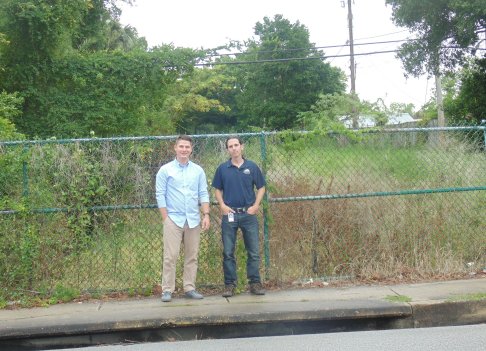by Victoria Parsons
With stormwater ranked as an important source of contaminants to Tampa Bay, local governments most often focus on affordable ways to capture stormwater before it escapes into larger rivers or the bay itself.
That’s not necessarily the case in the Delaney Creek watershed, an area about 10 square miles located east of Brandon and south of Palm River in southern Hillsborough County. Stormwater is definitely an issue for county staff, but most residents are more concerned about crime, litter, flooding, transportation and employment opportunities.
“Stormwater is our top priority but we can make stormwater infrastructure here more than just stormwater,” said Anthony Betts, environmental scientist for Hillsborough County’s stormwater program. “Other cities have built stormwater projects that include pathways and open space so residents can enjoy the water rather than avoid it.”
Delaney Creek is a diverse neighborhood that includes heavy industry, commercial uses, 1950s residential areas and even some rural areas with livestock, so part of the problem is identifying the exact source of the pollution. In some cases, older septic tanks have been disabled and turned into cess pits that drain directly into creeks or ditches. In other cases, pigs and horses are being bred so near the canals that their waste runs directly off the property and into the water.

To make sure they address the most important sources, the Delaney Creek team turned into detectives, measuring water for sucralose and acetaminophen — also known as Sweet’N Low and Tylenol. “Those are substances not fed to animals so if they’re there, we know they are from human waste,” said Anita Nash, environmental consultant with the Florida Department of Environmental Protection.
And to bring residents onboard with preventing pollution, the team even includes a social marketing research consultant. “We’ve held focus groups in the community and then reached out to survey larger groups,” notes Jennifer Aragon, environmental specialist. “A lot of people care about the creek and are concerned if it tested as polluted.”
But there are quirks in the responses, she adds. “When people are asked if it’s a problem that should be fixed by residents or by government, they respond that they’d put more effort into it if the government does first.” Another important point: “More people would encourage their friends and family to be part of a clean-up effort than would join themselves,” she said.
Education will be critical because residents indicated that they think that neither human or animal waste is a big deal. “One resident with an open cess pit asked us to build him another one,” adds John McGee, chief environmental scientist and stormwater environmental programs coordinator for the county’s public works department. “Another house had a pipe that fed sewage directly into the creek — the owner just told us he hadn’t done it.”
Rather than focus on violations, the team works to bring residents into compliance by explaining the damage residents are causing to the environment — and potential health impacts to their neighborhood. “We get mostly positive responses — once they understand what we’re doing, the hostility subsides,” said Ryan Riordan, environmental specialist.
Watershed advantages
Like nearly every creek that once meandered through the Tampa Bay region, Delaney Creek was channelized for flood control with straight, steep-sided channels that move water off low-lying land quickly. Unlike many areas, however, the channels and surrounding right-of-way are wide enough to accommodate more than just a creek.

Usable pathways are particularly important because the neighborhood lacks easy bicycle or pedestrian access to the nearby Westfield Brandon Mall, an essential destination for both employment opportunities and shopping. One of the widest — but least attractive — segments of the creek is across the street from Dowdell Middle School, which offers magnet programs in environmental sciences, creating the perfect opportunity for students to learn about water quality.
Improving stormwater systems will help increase the value of homes in the neighborhoods where flooding is an issue. The county is also looking at installing sewer lines to replace the older septic systems.
Plans for Delaney Creek are still being finalized, but the stormwater team is focused on creating the best outcomes for the entire community. “This is the low-hanging elephant,” McGee quips. “It’s such a mess that we can make major strides in improving water quality.”